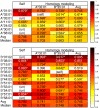Large-scale characterization of peptide-MHC binding landscapes with structural simulations
- PMID: 21478437
- PMCID: PMC3084072
- DOI: 10.1073/pnas.1018165108
Large-scale characterization of peptide-MHC binding landscapes with structural simulations
Abstract
Class I major histocompatibility complex proteins play a critical role in the adaptive immune system by binding to peptides derived from cytosolic proteins and presenting them on the cell surface for surveillance by T cells. The varied peptide binding specificity of these highly polymorphic molecules has important consequences for vaccine design, transplantation, autoimmunity, and cancer development. Here, we describe a molecular modeling study of MHC-peptide interactions that integrates sampling techniques from protein-protein docking, loop modeling, de novo structure prediction, and protein design in order to construct atomically detailed peptide binding landscapes for a diverse set of MHC proteins. Specificity profiles derived from these landscapes recover key features of experimental binding profiles and can be used to predict peptide binding with reasonable accuracy. Family wide comparison of the predicted binding landscapes recapitulates previously reported patterns of specificity divergence and peptide-repertoire diversity while providing a structural basis for observed specificity patterns. The size and sequence diversity of these structure-based binding landscapes enable us to identify subtle patterns of covariation between peptide sequence positions; analysis of the associated structural models suggests physical interactions that may mediate these sequence correlations.
Conflict of interest statement
The authors declare no conflict of interest.
Figures






Similar articles
-
NetMHCpan, a method for quantitative predictions of peptide binding to any HLA-A and -B locus protein of known sequence.PLoS One. 2007 Aug 29;2(8):e796. doi: 10.1371/journal.pone.0000796. PLoS One. 2007. PMID: 17726526 Free PMC article.
-
Changes at the floor of the peptide-binding groove induce a strong preference for proline at position 3 of the bound peptide: molecular dynamics simulations of HLA-A*0217.Biopolymers. 2000 Oct 15;54(5):318-27. doi: 10.1002/1097-0282(20001015)54:5<318::AID-BIP30>3.0.CO;2-T. Biopolymers. 2000. PMID: 10935972
-
Limitations of Ab initio predictions of peptide binding to MHC class II molecules.PLoS One. 2010 Feb 17;5(2):e9272. doi: 10.1371/journal.pone.0009272. PLoS One. 2010. PMID: 20174654 Free PMC article.
-
Interactions between immunogenic peptides and MHC proteins.Annu Rev Immunol. 1991;9:527-65. doi: 10.1146/annurev.iy.09.040191.002523. Annu Rev Immunol. 1991. PMID: 1910688 Review.
-
Predicting peptide binding to Major Histocompatibility Complex molecules.Autoimmun Rev. 2011 Jun;10(8):469-73. doi: 10.1016/j.autrev.2011.02.003. Epub 2011 Feb 16. Autoimmun Rev. 2011. PMID: 21333759 Review.
Cited by
-
Large-Scale Structure-Based Prediction of Stable Peptide Binding to Class I HLAs Using Random Forests.Front Immunol. 2020 Jul 22;11:1583. doi: 10.3389/fimmu.2020.01583. eCollection 2020. Front Immunol. 2020. PMID: 32793224 Free PMC article.
-
Structural Prediction of Peptide-MHC Binding Modes.Methods Mol Biol. 2022;2405:245-282. doi: 10.1007/978-1-0716-1855-4_13. Methods Mol Biol. 2022. PMID: 35298818 Review.
-
A novel C2H2-type zinc-finger transcription factor, CitZAT4, regulates ethylene-induced orange coloration in Satsuma mandarin flavedo (Citrus unshiu Marc.).J Integr Plant Biol. 2025 Feb;67(2):294-310. doi: 10.1111/jipb.13778. Epub 2024 Sep 24. J Integr Plant Biol. 2025. PMID: 39315817 Free PMC article.
-
Identification and biophysical characterization of Plasmodium peptide binding by common African HLAs.Sci Rep. 2025 Mar 12;15(1):8614. doi: 10.1038/s41598-025-92191-6. Sci Rep. 2025. PMID: 40074802 Free PMC article.
-
Main Strategies for the Identification of Neoantigens.Cancers (Basel). 2020 Oct 7;12(10):2879. doi: 10.3390/cancers12102879. Cancers (Basel). 2020. PMID: 33036391 Free PMC article. Review.
References
-
- Mungall AJ, et al. The DNA sequence and analysis of human chromosome 6. Nature. 2003;425:805–811. - PubMed
-
- Phillips EJ, Mallal SA. Hla and drug-induced toxicity. Curr Opin Mol Ther. 2009;11:231–242. - PubMed
-
- Garrido F, et al. Implications for immunosurveillance of altered HLA class I phenotypes in human tumours. Immunol Today. 1997;18:89–95. - PubMed
-
- Petersdorf EW. HLA matching in allogeneic stem cell transplantation. Curr Opin Hematol. 2004;11:386–391. - PubMed
Publication types
MeSH terms
Substances
LinkOut - more resources
Full Text Sources
Research Materials

